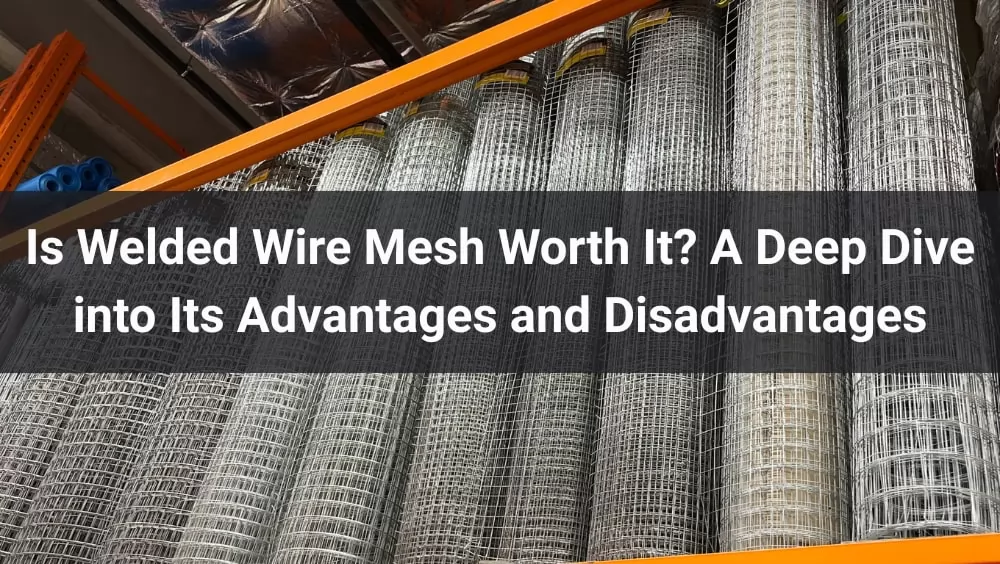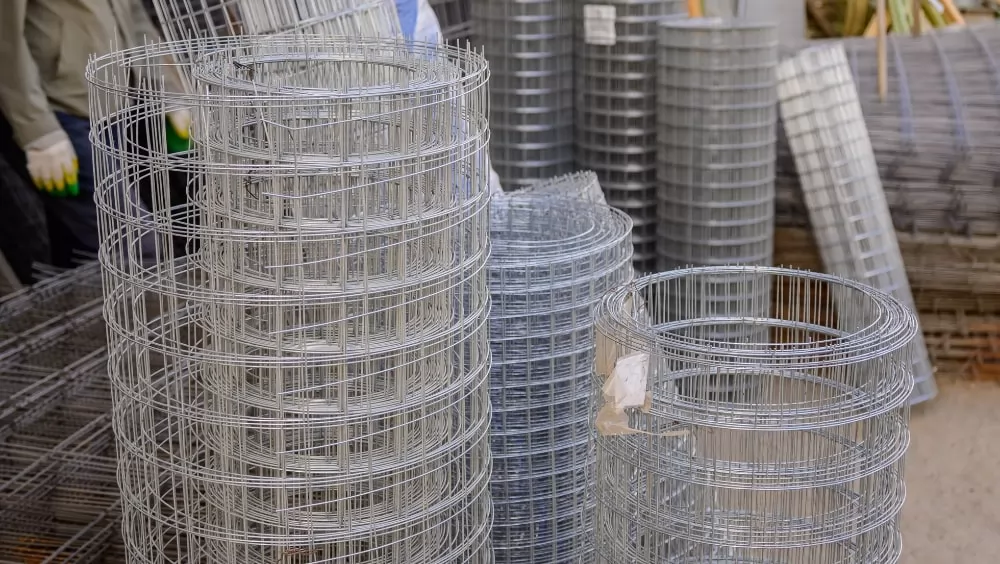





Welded wire mesh is everywhere — from fences and cages to concrete reinforcement. But is it really the best option for your project? Many people wonder if its advantages truly outweigh the drawbacks.
Before you decide, it’s worth taking a closer look at what makes welded wire mesh strong, where it performs best, and what limitations you should know.
In this guide, you’ll find a clear breakdown of the pros and cons, practical comparisons, and common questions to help you choose wisely.

Welded wire mesh is a grid-like structure made by welding intersecting horizontal and vertical steel wires together at each crossing point. This welding process ensures consistent mesh size, strong structural integrity, and high load-bearing capacity while preventing loosening or deformation. Welded wire mesh is commonly supplied in panels or rolls and is widely used for fencing, protective barriers, concrete reinforcement in construction, animal cages, shelving, partitions, and many other structural and functional applications. It offers advantages such as easy installation, good workability, and long service life,can be divided into:
Galvanized welded wire mesh is made from high-quality low carbon steel wire, precisely welded and then coated with zinc through hot-dip or electro-galvanizing. The uniform and firm zinc layer offers strong adhesion and corrosion resistance by effectively isolating the steel from air and moisture. With a clean appearance, sturdy structure, and good strength, it is ideal for long-term outdoor use with minimal maintenance, offering excellent cost-performance value.
Applications: Farm fencing, livestock enclosures, construction site barriers, warehouse protection, temporary facility fences.
Main Advantages: Rust-resistant, cost-effective, stable structure, easy installation and maintenance.
Stainless steel welded mesh is made from premium 304 or 316 stainless steel wires, precision-welded to form a strong, flat mesh. It offers outstanding rust and corrosion resistance, especially in humid, acidic, or marine environments. With a smooth surface and high mechanical strength, it remains undeformed and safe to use. It meets hygiene requirements for food and pharmaceutical industries, contains no harmful substances, and has a significantly longer lifespan than galvanized mesh, making it ideal for high-quality and durable use.
Applications: Food processing equipment, pharmaceutical cleanrooms, chemical filtration, offshore platforms, upscale architectural decoration, industrial screening.
Main Advantages: Excellent corrosion resistance, high strength, long service life, hygienic and safe, heat and pressure resistant.
PVC coated welded wire mesh is produced by applying a uniform, weather-resistant layer of polyvinyl chloride (PVC) over galvanized wire mesh. This coating enhances rust and moisture protection, while offering a smoother surface and improved appearance. The flexible coating helps absorb impacts and prevents injury to people or animals. Available in various colors (commonly green or black), it blends well with natural surroundings, providing both decorative and functional value. Its resistance to sun, rain, and abrasion makes it a popular choice for residential and garden applications.
Applications: Residential fences, garden enclosures, sports field barriers, pet cages, children's safety zones, school and park facilities.
Main Advantages: Excellent corrosion protection, attractive appearance, safe and eco-friendly, UV and weather resistant, color options available.
| No. | Advantage | Brief Description |
|---|---|---|
| 1 | High Strength and Structural Stability | Spot welding creates a strong grid that resists bending and impacts, suitable for heavy load applications. |
| 2 | Easy and Efficient Installation | Uniform mesh is easy to cut and shape, reducing construction time and errors. |
| 3 | Versatile Applications Across Industries | Available in various sizes and materials, ideal for agriculture, construction, mining, and more. |
| 4 | Excellent Visibility and Airflow | Open grid design ensures clear sight and ventilation, perfect for fencing and partitions. |
| 5 | Low Maintenance Over Time | Galvanized or PVC coated to resist corrosion, suitable for outdoor use. |
| 6 | Long-Term Structural Integrity | Fixed weld points maintain shape stability and prevent loosening. |
| 7 | Eco-Friendly and Recyclable | Made from recyclable metals supporting sustainable building practices. |
| 8 | Economical for Large-Scale Projects | Cost-effective and ideal for large-area construction with great value. |
| 9 | Safe and User-Friendly Design | Smooth surface with no sharp edges reduces injury risk, ideal for schools and parks. |
| 10 | Adaptable to Complex Surfaces and Shapes | Easy to shape for modern architecture, sculpture reinforcement, and creative designs. |
One of the key advantages of welded wire mesh is its exceptional structural strength. The rigid intersections created by precise spot welding form a stable and durable grid that resists bending, impacts, and deformation under heavy loads. This makes it a preferred material for demanding applications such as concrete reinforcement, machine guards, and industrial fencing. When evaluating the benefits and drawbacks of welded mesh, its long-lasting strength is consistently listed as a major asset.
Welded mesh is incredibly easy to handle and install. Thanks to its uniform grid pattern and solid structure, it can be quickly cut, bent, or shaped using standard tools, making it ideal for fast-paced construction or fencing projects. Its simplicity reduces labor time and minimizes errors during installation. As part of the pros of using welded mesh fencing, this ease of use is particularly appealing to contractors seeking efficient, cost-saving solutions.
Available in a wide range of mesh sizes, wire gauges, and finishes—including galvanized, stainless steel, and PVC-coated—welded mesh adapts to countless scenarios. From agriculture and architecture to mining and interior design, its flexibility in function and form makes it a truly multi-purpose wire mesh solution. This versatility is a major reason it’s favored when comparing the advantages and disadvantages of different mesh types.
The open-grid design of welded mesh allows for clear visibility and free airflow, which is essential for areas that require both security and ventilation. It is commonly used in animal enclosures, garden fencing, and factory partitions where supervision and circulation are important. Among the positive aspects of welded mesh fencing, its see-through nature is both practical and aesthetically pleasing.
Thanks to protective coatings like hot-dip galvanization or PVC layering, welded wire mesh is highly resistant to corrosion, rust, and environmental wear. It performs well in outdoor and humid environments without frequent maintenance. This makes it a low-maintenance fencing material and an excellent long-term investment, especially when evaluating the pros and cons of wire mesh for outdoor use.
Unlike woven mesh, which can loosen over time, welded mesh retains its form due to the fixed bonds at each intersection. This ensures long-term dimensional stability, even under continuous stress or environmental changes. This durability is why it's a trusted option in high-stakes areas like highway reinforcement and infrastructure. It's a standout feature when assessing the long-term benefits of welded mesh versus woven wire.
Welded mesh is typically made from recyclable metals such as steel or stainless steel, making it an environmentally responsible choice. It supports sustainable building practices and contributes to waste reduction on construction sites. As more projects prioritize green materials, the environmental benefits of welded mesh become increasingly relevant in modern applications.
In terms of cost-effectiveness, welded wire mesh offers great value, especially when used in bulk for large-area fencing, retaining walls, or concrete reinforcement. Its combination of strength, longevity, and affordability makes it a smart choice for budget-conscious projects. Compared to other materials, the cost-performance ratio of welded mesh panels is highly favorable.
Safety is another important benefit of welded mesh. The flat, smooth surface with no loose wires or sharp edges minimizes the risk of cuts or injuries during installation and everyday use. This makes it ideal for applications in schools, parks, and residential areas where safety is a priority. In discussions of the advantages and disadvantages of fencing options, welded mesh stands out for its user-safe design.
Whether used on flat walls, curved frameworks, or custom 3D structures, welded wire mesh is easy to shape and secure. This adaptability makes it valuable for modern architecture, sculpture reinforcement, and creative design work. As a flexible and customizable fencing solution, it meets the needs of both functional and decorative projects.
| No. | Disadvantage | Brief Description |
|---|---|---|
| 1 | Susceptible to Corrosion (If Uncoated) | Uncoated steel mesh rusts easily in moist or chemical environments, reducing durability outdoors. |
| 2 | Limited Flexibility and Formability | Rigid welded mesh cannot easily bend or adapt to curved or uneven surfaces like woven wire. |
| 3 | Cost of High-End Materials | Premium materials increase costs, which can outweigh benefits on large projects compared to alternatives. |
| 4 | Not Suitable for Ultra-High Security | Standard mesh is vulnerable to cutting and less ideal for critical security needs like prisons or military zones. |
| 5 | Sharp Ends if Improperly Cut | Cut edges can be sharp and dangerous if not properly treated, posing safety risks. |
| 6 | Difficult to Transport in Large Sheets | Rigid panels are bulky and hard to ship, requiring special handling and raising costs. |
| 7 | Limited Vibration Absorption | Does not absorb vibrations well, leading to fatigue or cracking in dynamic environments. |
| 8 | Difficult to Repair if Damaged | Damaged sections often require full replacement, complicating maintenance efforts. |
| 9 | Not Ideal for Temporary Installations | Its permanence and rigidity limit use for temporary or movable fencing solutions. |
| 10 | Aesthetic Limitations for Certain Designs | Rigid grid pattern may clash with architectural or decorative styles, limiting design appeal. |
Uncoated or plain steel welded mesh is vulnerable to rust and corrosion when exposed to moisture, humidity, or chemicals. Without proper galvanization or PVC coating, the wire mesh may deteriorate quickly, especially in outdoor or marine environments. This is a key consideration in evaluating the cons of wire mesh fencing for long-term use.
The rigid structure of welded wire mesh means it cannot easily be bent or reshaped after manufacturing. Unlike woven wire, which offers more flexibility, welded mesh is difficult to adapt to curved or uneven surfaces. This lack of adaptability is one of the more common limitations of welded mesh panels in creative or complex installations.
Premium options like stainless steel or thick-gauge PVC-coated welded mesh can significantly increase material costs. For large projects, the total expense can outweigh the benefits, especially when alternatives such as chain-link fencing offer lower pricing. This is often cited among the financial drawbacks of welded mesh fencing.
Standard welded mesh fencing does not provide the same level of protection as high-security systems. It may be vulnerable to cutting or breaching if used in prisons, airports, or military zones. This makes it a less-than-ideal option in critical security applications.
When welded mesh is trimmed on-site, the cut ends can be sharp and hazardous if not treated or covered properly. These exposed edges pose a safety risk to workers, animals, or the public. It's a practical issue to keep in mind when discussing the safety-related disadvantages of wire mesh.
Because welded mesh panels are rigid and flat, transporting them in bulk or over long distances can be cumbersome. They often require special handling or oversized packaging, which adds to shipping complexity and cost. This is one of the logistical disadvantages of welded mesh panels.
Welded wire mesh does not absorb mechanical vibration well. In applications where dynamic loads or movement is frequent, such as in vibrating machinery or mobile structures, the rigid mesh may experience fatigue or even cracking over time. This mechanical limitation reduces its suitability in industrial vibration environments.
If part of a welded mesh panel is bent, broken, or corroded, the entire section often needs replacement. Unlike modular fencing systems, it's hard to perform localized repairs without compromising structural integrity. This makes maintenance more labor-intensive and is considered a maintenance drawback of welded mesh fencing.
The permanence and rigidity of welded mesh make it less suitable for temporary or movable fencing solutions. For construction zones or event enclosures, more flexible alternatives like plastic mesh or modular panels may be preferred. This reflects its lack of versatility in temporary applications.
While welded mesh has a clean, industrial look, it may not suit all architectural or decorative environments. Its rigid and repetitive grid pattern may conflict with certain visual styles or landscape designs. This is a common reason it's excluded from projects that prioritize architectural aesthetics over utility.

| Material | Strength | Corrosion Resistance | Cost | Best Use Cases |
|---|---|---|---|---|
| Welded Wire Mesh | High | Good (with coating) | Moderate | Fencing, cages, reinforcement |
| Chain Link Fencing | Moderate | Good | Low to Moderate | Residential and sports fields |
| Expanded Metal Mesh | Very High | Excellent | Higher | Security, walkways, grating |
| Woven Wire Mesh | Flexible | Varies | Varies | Filtration, decorative use |
Welded Wire Mesh, also referred to as welded wire fabric or welded grid, offers high strength and good corrosion resistance when properly coated. It is moderately priced and widely used in fencing, animal enclosures, and concrete reinforcement thanks to its solid balance of durability, rigidity, and cost-effectiveness. This makes it a go-to choice for both residential and industrial projects where long-term performance is essential without exceeding budget.
Chain link fencing offers moderate strength and decent corrosion resistance at a relatively low to moderate cost, making it popular for residential yards and sports fields where budget and quick installation are key. In contrast, welded wire mesh—also referred to as welded wire fabric—provides enhanced rigidity and long-term durability, thanks to its fixed welded joints. While chain link’s flexibility suits temporary or less demanding setups, welded wire mesh stands out in applications requiring more structural stability and resistance to wear, offering a balanced mix of strength, longevity, and cost-effectiveness.
Expanded Metal Mesh is known for very high strength and excellent corrosion resistance but is generally more expensive. Compared to expanded metal, welded wire mesh—also called welded wire fabric—offers good strength and durability at a lower cost, making it suitable for many applications.
Woven Wire Mesh is characterized by its flexibility, making it highly adaptable for various applications. Its strength and corrosion resistance depend on the type of material used and the specific weave pattern. Due to its flexible structure, woven mesh is ideal for filtration and decorative uses, where adaptability and appearance are prioritized over rigidity. However, woven mesh may experience loosening over time and generally offers less structural stability compared to welded wire mesh.
When choosing, consider factors like strength, cost, weather exposure, and security requirements.

Choose the material and coating based on where and how you’ll use the mesh. Stainless steel is best for corrosive or coastal environments. Galvanized steel works well outdoors with moderate weather exposure, while PVC coating adds extra protection and a clean look for residential or farm use. Always match the wire gauge and mesh size to your project’s strength and safety needs.
Prepare the site well — level the surface and secure the mesh firmly. Use strong fasteners or ties to hold panels together and overlap sections to maintain strength. For fencing, make sure posts are stable and tension is applied correctly to prevent sagging. Proper installation helps the mesh stay strong and last longer.
Inspect the mesh regularly for rust, coating damage, or broken welds. Clean dirt and debris that could speed up corrosion. For outdoor or harsh settings, consider re-coating or replacing damaged areas to extend its lifespan. A simple maintenance routine keeps your welded wire mesh performing at its best.

A1: Welded mesh is more stable and resistant to deformation due to spot welding, making it ideal for heavy loads and long-term use. Woven mesh is more flexible but may loosen over time.
A2: With proper coatings like galvanizing or PVC, it resists rust and needs minimal upkeep, making it low-maintenance over its lifespan.
A3: Welded mesh is harder and provides stronger protection, fitting high-security needs. Woven mesh is looser and more flexible, better suited for lower-security or flexible applications.
A4: Generally no; for heavy security, thicker gauge or alternative barriers are preferred as welded mesh may not fully prevent breaches.
A5: It’s moderately priced—more expensive than chain link but cheaper than stainless steel or expanded metal mesh options.
Welded wire mesh can be a smart choice if you need strength, good durability, and easy installation at a fair cost. But don’t forget to match it to your environment and security needs.
Understanding both the advantages and the downsides means you can avoid unexpected problems and get the best results for your budget. If you want high-quality welded wire mesh that lasts, consider YANGZE — our trusted materials and service help you build with confidence.
If you're searching for "what is welded wire mesh," you likely need more than a definition—you need to understand how to use it, specify it, and choose the right type for your project.
To cut through the clutter, we have carefully selected the top 10 wire mesh manufacturers and suppliers in the world after evaluating over 100 wire mesh companies.
The manufacturers and suppliers listed above represent some of the most reliable metal mesh suppliers in the UAE , serving projects across Dubai, Sharjah, and the wider region.
